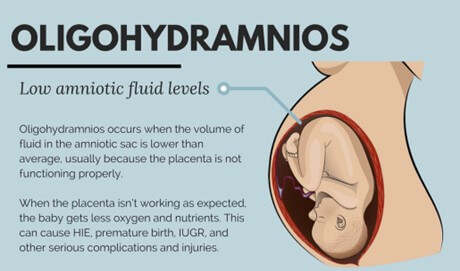Which of these clients is at greatest risk for umbilical cord prolapse?
A client who is pregnant with twins
A client who has gestational hypertension
A client who has oligohydramnios
A client who has placenta previa.
The Correct Answer is C
The correct answer is choice C. A client who has oligohydramnios.
Oligohydramnios is a condition where there is too little amniotic fluid around the fetus. This can cause the umbilical cord to slip down into the cervix or vagina before the baby, resulting in cord prolapse.
Cord prolapse can cut off the blood and oxygen supply to the baby and cause fetal distress or death.
Choice A is wrong because a client who is pregnant with twins is not at greater risk for cord prolapse unless there is also malpresentation of the fetuses, such as breech or transverse lie.
Choice B is wrong because a client who has gestational hypertension is not at greater risk for cord prolapse unless there is also polyhydramnios, which is excessive amniotic fluid around the fetus.
Choice D is wrong because a client who has placenta previa is not at greater risk for cord prolapse unless there is also artificial rupture of membranes by doctors.

Nursing Test Bank
Naxlex Comprehensive Predictor Exams
Related Questions
Correct Answer is A
Explanation
The correct answer is choiceA.
The nurse should instruct the client to avoid lifting anything heavier than the newborn for 6 weeks.This is because lifting heavy objects can strain the abdominal muscles and the incision site, and increase the risk of bleeding and infection.
ChoiceBis wrong because the nurse should advise the client to wait at least 4 to 6 weeks before resuming sexual intercourse.This is to allow the incision to heal and prevent infection and discomfort.
ChoiceCis wrong because the nurse should not recommend ibuprofen for pain relief as it can interfere with blood clotting and increase bleeding.The nurse should suggest acetaminophen or a prescribed analgesic instead.
ChoiceDis wrong because the nurse should not tell the client to report any foul-smelling vaginal discharge to the provider.
The client should expect some vaginal discharge (lochia) for several weeks after a cesarean delivery, which may have a mild odor.However, the nurse should instruct the client to report signs of infection such as fever, chills, redness, swelling, or increased pain at the incision site.
Correct Answer is D
Explanation
The correct answer is choice D. A patient who is 34 weeks pregnant with a breech presentation and ruptured membranes.This is because breech presentation and ruptured membranes are both risk factors for umbilical cord prolapse, which is where the umbilical cord descends through the cervix and is alongside or below the presenting part of the fetus.This can cause fetal hypoxia and distress.
Choice A is wrong because a cephalic presentation and intact membranes are not risk factors for umbilical cord prolapse.
Choice B is wrong because although twins and ruptured membranes are risk factors for umbilical cord prolapse, the risk is lower than in choice D. Choice C is wrong because although a transverse lie is a risk factor for umbilical cord prolapse, the risk is lower than in choice D if the membranes are intact.
Whether you are a student looking to ace your exams or a practicing nurse seeking to enhance your expertise , our nursing education contents will empower you with the confidence and competence to make a difference in the lives of patients and become a respected leader in the healthcare field.
Visit Naxlex, invest in your future and unlock endless possibilities with our unparalleled nursing education contents today
Report Wrong Answer on the Current Question
Do you disagree with the answer? If yes, what is your expected answer? Explain.
Kindly be descriptive with the issue you are facing.
